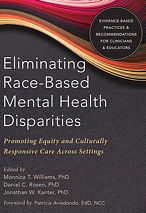Bias
Is Your Therapist Qualified to Treat People of Color?
Ten questions that all culturally-informed therapists should be able to answer.
Posted May 31, 2019 Reviewed by Jessica Schrader
As our country is becoming increasingly diverse, it is more important than ever for clinicians to be ready to meet the needs of clients from varied ethnic, racial, and cultural backgrounds. Currently, in the United States, 39 percent of our population are people of color, including those of Black, Hispanic, Asian, Native/Indigenous heritage, and multiracial individuals. Half of children and new births are people of color, and according to the U.S. Census, White people will be a minority by 2045. Because of our changing demographics, therapists today need to be skilled in working with clients from many different ethnic groups, cultures, and communities.
When I graduated with my doctorate in clinical psychology in 2007, there were no courses in multicultural counseling skills required or even offered in my graduate program. Although most new therapists are emerging from training programs with at least some basic multicultural education, there is a whole generation of practitioners who were never exposed to any such training at all. Thus, it would be a mistake to assume that any given therapist knows how to work effectively with people from different ethnic and racial backgrounds. Because of gaps in training, older, more experienced therapists may be even less skilled than newly-minted clinicians.
When clinicians lack needed skills and knowledge to effectively interact with those who are ethnoracially different, clients of color may be left feeling misunderstood, invalidated, or sometimes even traumatized. As a result, people of color may fail to return for treatment after just a single session.
If you are a person of color, how can you know if your therapist is equipped to work with people like you? Here is a list of 10 questions that every therapist should answer before working with people across racial and ethnic differences.
1. Have you had at least a one-semester graduate course focused on multicultural counseling skills? How have you applied it in your professional work?
It seems that social workers and counselors usually have some formal training in culturally-informed care, but for clinical psychologists, training is spotty, and for psychiatrists, it tends to be exceptionally thin. Ideally, clinicians should have had two semesters of diversity training that include an experiential component emphasizing self-reflection. For those who haven’t had coursework, it would be important to know what (if any) training they sought out on their own. It is possible to get continuing education credits for diversity-focused training, and some states require it.
2. Have you had useful clinical supervision focused on issues surrounding race, ethnicity, and culture? If so, how did it aid your professional work?
Classroom learning is important, but it is no substitute for supervised hands-on work with diverse clients. Therapists should have experience working under a supervisor who can skillfully help navigate issues surrounding culture, race, and stigma with their clients.
3. Have you prepared a written cultural conceptualization about a client that was subsequently evaluated by a knowledgeable supervisor?
Therapists should be able to devise a case formulation with culturally-specific understandings of the social, emotional, and psychological factors that impact the health and well-being of their clients. They should understand the client’s explanatory models for the causes of their symptoms, and be able to anticipate when culturally-specific adaptations may be needed to established protocols.
4. Are you willing to address racial differences with clients early in therapy? Give an example of how you approach this and how it has worked.
If therapists are unable or unwilling to discuss racial or ethnic identity with clients of color, it can appear that the therapist is uncomfortable with these kinds of differences. Clients should feel that therapists are able to easily talk about any issues that could be important for the development of the therapeutic relationship.
5. Do you feel competent to ask about, respond to, and support clients regarding their experiences of racism, oppression, and intersectionality? Discuss any challenges and successes you had.
Almost all people of color experience some degree of racism or prejudice in Western culture. If therapists aren’t having these conversations with clients, they are missing an important piece of the client’s lived experiences—and a potential target for therapeutic intervention.
6. Can you talk about White privilege and what it means to be White? If you identify as White, identify several areas of privilege you did not realize were a privilege of being White until you learned about White privilege.
Racism is based on a social system that unfairly disadvantages some to the benefits of others. You can’t have an intelligent conversation about racism without understanding the role of White privilege.
7. Can you explain the impact of racial/ethnic identity development on the therapeutic alliance?
Both clients and therapists vary in their process of how race and ethnicity fit into their understanding of their identity. These conceptualizations influence how people feel about themselves and those from other groups.
8. How many people of color have you seen consistently for at least 10 visits?
When asked about their experience working with people of color, many therapists will say they’ve seen “lots of diverse clients.” But there is a difference between seeing a client a few times and actually helping them. If clients of color are willing to keep coming back, that’s a good sign.
9. How would you respond if your client said you were a racist? Given that this question may require more context, assume that the client believes that because you are either White or not the same race as they are. If you have an actual example you can share, please do so.
Therapists need to be able to respond in a helpful way to clients who may have fairly or unfairly developed negative perceptions of their clinician. And sometimes even well-intentioned therapists unknowingly show racial bias or commit a microaggression, including therapists who value fairness and equality.
10. Can you identify multiple sources of structural racism in your place of employment? If you do not have a current place of employment, think about a past place of employment.
Many of our country’s institutions, policies, procedures, laws, and statutes were crafted to advantage White people at the expense of people of color. These underpinnings continue to propagate inequality in everyday life. Structural racism does not require the actions of any one biased person to perpetuate discrimination against people of color.
Are you a therapist? How did you do?
Being able to answer all of these questions well does not guarantee cultural competence, but it is a promising start. If you are a therapist and some of these questions have stumped you, this is an indication that it's time to learn more to better serve your clients of color. There are many good books, workshops, and training opportunities available to help you gain essential knowledge or update skills you already have.

Look for my new book on working with people of color: Eliminating Race-Based Mental Health Disparities: Promoting Equity and Culturally Responsive Care Across Settings. Available online.
The comment area is open! If you are a therapist, please share how have you addressed any of these issues with clients of color. If you are a client, it would be great to hear your experiences working with therapists from a different race.
References
Williams, M. T., Rosen, D. C., & Kanter, J. W. (2019). Eliminating Race-Based Mental Health Disparities: Promoting Equity and Culturally Responsive Care Across Settings. New Harbinger Books. ISBN: 978-1-68403-196-2
Bardone-Cone, A. M., Calhoun, C. D., Fischer, M. S., Gaskin-Wasson, A. L., Jones, S. T., Schwartz, S. L., & ... Prinstein, M. J. (2016). Development and implementation of a diversity training sequence in a clinical psychology doctoral program. The Behavior Therapist, 39(3), 65-75.
DiAngelo, R. (2011). White Fragility. The International Journal of Critical Pedagogy, 3 (3), 54-70.
Graham-LoPresti, J., Williams, M. T., & Rosen, D. C. (2019). Culturally responsive assessment and diagnosis for clients of color. In M. T. Williams, D. C. Rosen, & J. W. Kanter (Eds.), Eliminating Race-Based Mental Health Disparities. Oakland, CA: New Harbinger Books.
Hays, P. A. (2009). Integrating evidence-based practice, cognitive-behavior therapy, and multicultural therapy: Ten steps for culturally competent practice. Professional Psychology: Research and Practice, 40(4), 354-360.
McIntosh, P. (2003). White privilege: Unpacking the invisible knapsack. In S. Plous (Ed.), Understanding prejudice and discrimination. New York, NY: McGraw-Hill.
Neville, H., Worthington, R., & Spanierman, L. (2001). Race, Power, and Multicultural Counseling Psychology: Understanding White Privilege and Color Blind Racial Attitudes. In Ponterotto, J., Casas, M, Suzuki, L, and Alexander, C. (Eds.), Handbook of Multicultural Counseling. Thousand Oaks, CA: SAGE.
Terwilliger, J. M., Bach, N., Bryan, C., & Williams, M. T. (2013). Multicultural versus Colorblind Ideology: Implications for Mental Health and Counseling. In A. Di Fabio (Ed.), Psychology of Counseling (pp. 111-122). Hauppauge, NY: Nova Science Publishers. ISBN-13: 978-1-62618-410-7.
Williams, M. T. (2019). Adverse racial climates in academia: Conceptualization, interventions, and call to action. New Ideas in Psychology, 55, 58-67. doi: 10.1016/j.newideapsych.2019.05.002
Williams, M. T., Reed, S., & Aggarwal, R. (in press). Culturally-informed research design issues in a study for MDMA-assisted psychotherapy for posttraumatic stress disorder. Journal of Psychedelic Studies. doi: 10.1556/2054.2019.016




